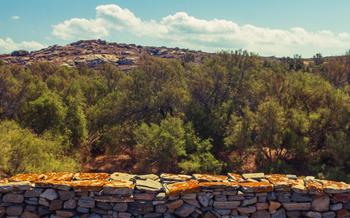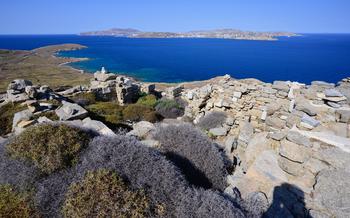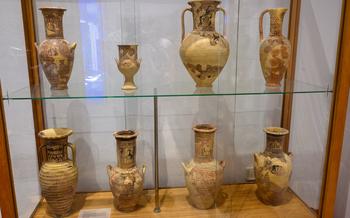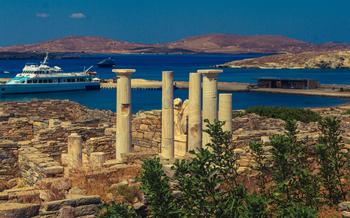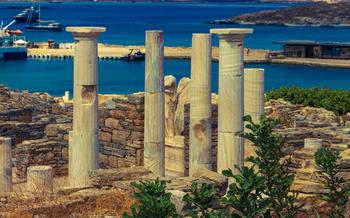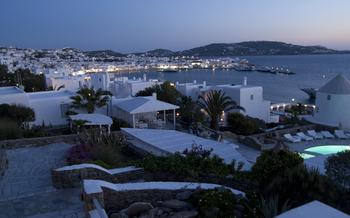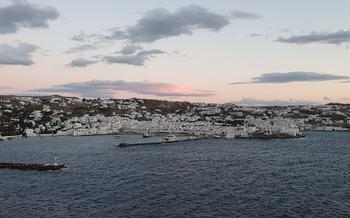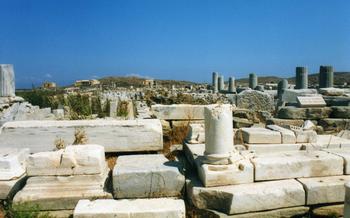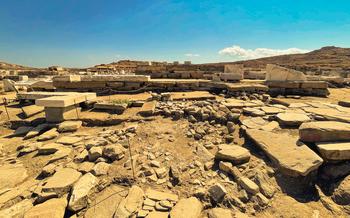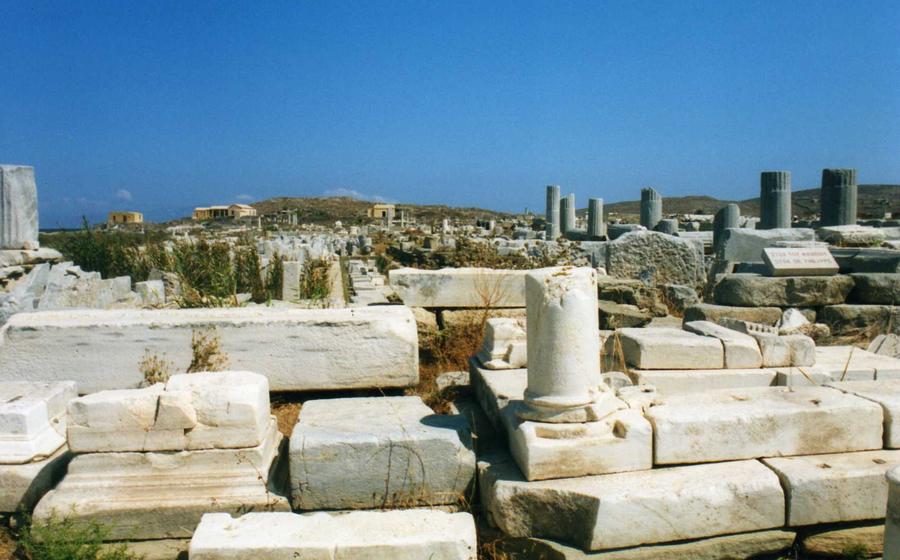
House of the Lake at Delos
- The House of the Lake: A Masterpiece of Hellenistic Architecture
- Location and Accessibility
- Exploring the House of the Lake: A Journey Through Time
- The Sacred Lake: A Place of Ritual and Purification
- The Terrace of the Lions: Guardians of the Sacred Precinct
- The Agora of the Italians: A Center of Trade and Commerce
- The Sanctuary of Apollo: A Sacred Precinct Steeped in Mythology
- The Museum of Delos: A Treasure Trove of Ancient Artifacts
- The Theater of Delos: A Stage for Ancient Performances
- The Necropolis: A Silent City of the Dead
- The Archaeological Site of Delos: A Living Museum of the Past
- Tips for Planning Your Visit to Delos
- Unforgettable Experiences at Delos
- Insider Tip: Discover the Hidden Gems of Delos
The House of the Lake: A Masterpiece of Hellenistic Architecture
Among the many remarkable structures on Delos, the House of the Lake stands out as a testament to the island's wealth and architectural prowess. Built in the 2nd century BC, this luxurious residence boasts a unique design that combines Hellenistic and Roman influences. The house is centered around a large peristyle courtyard, which features a stunning mosaic depicting a scene from Greek mythology. The courtyard is surrounded by a series of rooms, each with its own unique features. Some of the rooms have well-preserved frescoes, while others have intricate mosaics that depict scenes from everyday life. The House of the Lake is a testament to the skill and artistry of the ancient Greeks, and it offers a glimpse into the luxurious lifestyle of the island's elite.
Location and Accessibility
Delos, a small island in the Cyclades, is easily accessible from the cosmopolitan island of Mykonos, located just a few kilometers away. Regular ferry services operate between the two islands, providing a convenient and scenic mode of transportation. The journey takes approximately 30 minutes, offering breathtaking views of the Aegean Sea and the surrounding islands.
Once on Delos, visitors can choose to explore the island independently or join a guided tour. Guided tours are highly recommended, as they provide valuable insights into the island's history, mythology, and archaeological significance.
The best time to visit Delos is during the shoulder seasons (May-June and September-October) when the weather is pleasant and the crowds are smaller. During the summer months, the island can be crowded with tourists, making it challenging to fully appreciate its serene atmosphere and historical treasures.
Exploring the House of the Lake: A Journey Through Time
Stepping inside the House of the Lake is like stepping back in time to the days of ancient Greece. The house's layout is well-preserved, with a central courtyard surrounded by rooms that once served various functions. The walls are adorned with intricate mosaics depicting scenes from mythology and everyday life, offering a glimpse into the artistic and cultural traditions of the period.
Among the most impressive mosaics is one depicting Dionysus, the god of wine, surrounded by his followers. The colors are still vibrant, and the details are remarkably preserved, showcasing the skill and artistry of the ancient mosaicists. Another highlight is a mosaic of a hunting scene, with dogs chasing a deer through a lush forest. The expressions on the faces of the animals and the movement captured in the scene are truly remarkable.
In addition to the mosaics, the House of the Lake is also home to several well-preserved frescoes. These paintings depict various scenes, including mythological figures, landscapes, and daily activities. One particularly striking fresco shows a woman playing a lyre, her fingers dancing over the strings as she creates beautiful music.
Through these mosaics and frescoes, visitors can gain a deeper understanding of the daily life and customs of ancient Delos. They provide a glimpse into the world of the wealthy and powerful, who lived in luxurious homes filled with art and beauty.
The Sacred Lake: A Place of Ritual and Purification
The Sacred Lake, located at the heart of the sanctuary, held a profound religious significance in ancient Greek mythology. According to legend, Leto, the mother of Apollo and Artemis, sought refuge on Delos after being pursued by the wrathful goddess Hera. It was here, by the sacred lake, that she gave birth to her divine twins. The lake became a symbol of purity and renewal, associated with the cleansing rituals performed by pilgrims and worshippers.
Archaeological excavations have uncovered evidence of these rituals, including altars, votive offerings, and inscriptions dedicated to Apollo and Artemis. The lake's crystal-clear waters were believed to possess healing properties, and pilgrims would immerse themselves in its depths to seek purification and divine favor. The sacred lake served as a focal point for religious ceremonies, festivals, and processions, attracting devotees from across the ancient world.
The Terrace of the Lions: Guardians of the Sacred Precinct
Amidst the ruins of Delos, the Terrace of the Lions stands as a testament to the island's former glory and grandeur. This impressive terrace, located near the Sanctuary of Apollo, features a row of seven imposing marble lion sculptures, each measuring over two meters in length. These majestic creatures, carved with exquisite detail, were once part of a larger monument that adorned the sacred precinct.
The lions served as symbolic guardians of the sanctuary, fiercely protecting the sacred space from harm. Their imposing presence and regal bearing convey a sense of strength and power, befitting their role as protectors of the gods. The terrace offered a panoramic view of the surrounding landscape, allowing the lions to keep a watchful eye over the sacred precinct and the bustling city beyond.
The lions have weathered the passage of time and the elements, but their grandeur remains undiminished. Their stoic expressions and muscular physiques evoke a sense of awe and respect, reminding visitors of the enduring legacy of ancient Delos. The Terrace of the Lions is a must-see attraction, offering a glimpse into the island's rich history and the enduring power of its symbolism.
The Agora of the Italians: A Center of Trade and Commerce
In the heart of Delos, the Agora of the Italians stands as a testament to the island's bustling commercial activity in ancient times. Serving as a marketplace and meeting place, this vibrant agora was the center of economic life, where traders from across the Mediterranean gathered to exchange goods, ideas, and cultures.
The agora's well-preserved remains reveal a fascinating glimpse into the economic importance of Delos. Scattered throughout the area are the foundations of shops, warehouses, and public buildings, each contributing to the agora's lively atmosphere. The variety of architectural styles and building materials reflects the diverse origins of the merchants who frequented this bustling marketplace.
One of the most impressive structures within the agora is the Stoa of Antigonos, a long portico lined with shops and offices. Its elegant columns and intricate carvings hint at the wealth and opulence that characterized Delos's commercial endeavors. Other notable buildings include the Bouleuterion, where the city council met, and the Prytaneion, where officials were entertained and foreign dignitaries were received.
The Agora of the Italians is not merely a collection of ancient ruins; it is a stage on which the vibrant drama of ancient commerce unfolds. Here, one can almost hear the clamor of merchants hawking their wares, the laughter of friends meeting over a shared meal, and the clinking of coins as deals are struck. It is a place where the economic pulse of Delos beat strong, contributing to the island's prosperity and renown throughout the ancient world.
The Sanctuary of Apollo: A Sacred Precinct Steeped in Mythology
At the heart of Delos lies the Sanctuary of Apollo, a sacred precinct that served as the religious epicenter of the island. Dedicated to the worship of Apollo, the god of music, prophecy, and healing, this sanctuary was considered one of the most important religious sites in the ancient Greek world.
The sanctuary encompasses a vast complex of temples, altars, and other sacred structures, each holding a unique significance in the mythology and religious practices of Delos. The Temple of Apollo, the most prominent structure within the sanctuary, is a testament to the god's importance. Built in the 6th century BC, the temple features an impressive Doric colonnade and houses a colossal statue of Apollo, once revered as one of the Seven Wonders of the Ancient World.
Mythological tales intertwine with the history of the sanctuary. It is said that Apollo was born on Delos, the son of Zeus and Leto. To protect his mother during her labor, Zeus transformed the floating island into a solid mass, creating a safe haven for Apollo's birth. The sanctuary became a place of pilgrimage for those seeking Apollo's guidance and healing powers, and its fame spread far beyond the shores of Greece.
Archaeological excavations at the sanctuary have unearthed a wealth of artifacts, shedding light on the religious rituals and practices that took place within its sacred precincts. These discoveries, coupled with the mythological associations, make the Sanctuary of Apollo a captivating destination for history buffs and those seeking a glimpse into the spiritual beliefs of ancient Greece.
The Museum of Delos: A Treasure Trove of Ancient Artifacts
The Museum of Delos stands as a testament to the island's rich history and cultural significance. Within its walls, visitors can embark on a journey through time, exploring an extensive collection of artifacts that paint a vivid picture of ancient life on Delos.
Highlights of the museum's collection include exquisite sculptures, pottery, jewelry, and everyday objects that provide a glimpse into the daily lives and customs of the ancient Delians. Masterpieces such as the Winged Victory of Delos, a breathtaking marble statue of the goddess Nike, and the Naxian Sphinx, a mysterious creature with the body of a lion and the head of a woman, are must-sees for any visitor.
Interactive displays and educational programs at the museum bring the ancient world to life, making history accessible and engaging for visitors of all ages. Through these interactive experiences, visitors can learn about the island's role as a religious center, a trading hub, and a thriving cosmopolitan society.
The Museum of Delos is not merely a repository of artifacts; it is a gateway to understanding the essence of this ancient civilization. By immersing oneself in the museum's collection, visitors can gain a deeper appreciation for the cultural and historical significance of Delos, a place where myth, history, and archaeology intertwine to create a truly unforgettable experience.
The Theater of Delos: A Stage for Ancient Performances
Amidst the ruins of Delos, the ancient theater stands as a testament to the vibrant cultural life that once flourished on this sacred island. Constructed in the 3rd century BC, the theater was a focal point for entertainment and artistic expression. Its remarkably well-preserved structure allows visitors to envision the lively performances that captivated audiences centuries ago.
The theater's architecture is a marvel of engineering, showcasing the ingenuity of ancient Greek builders. With a seating capacity of approximately 5,500 spectators, it is one of the largest theaters in the Cyclades. The steeply raked seating rows provide excellent sightlines, ensuring that every member of the audience had an unobstructed view of the stage.
The theater hosted a variety of performances, including plays, musical concerts, and dance recitals. It was a place where renowned artists from across the Greek world showcased their talents. The acoustics are exceptional, allowing the actors' voices to carry clearly throughout the auditorium.
The theater's stage is relatively small compared to modern standards, but it was sufficient for the intimate performances of ancient times. The backdrop of the stage is adorned with intricate bas-reliefs depicting scenes from Greek mythology, adding to the immersive experience for the audience.
Today, the Theater of Delos stands as a silent witness to the rich cultural heritage of ancient Greece. It is a reminder of the importance that the ancient Greeks placed on the arts and entertainment. Ongoing restoration efforts aim to preserve this magnificent structure for future generations to appreciate.
The Necropolis: A Silent City of the Dead
Nestled on a hillside overlooking the ancient city, the necropolis of Delos serves as a poignant reminder of the island's rich history and the final resting place of its inhabitants. As you wander through the labyrinthine paths, you'll encounter a diverse array of tombs and burial chambers, each offering a glimpse into the lives and beliefs of those who once called Delos home.
From simple pit graves to elaborate mausoleums, the tombs vary in size and style, reflecting the social status and wealth of the deceased. Some tombs feature intricate carvings and inscriptions, providing clues about the individuals buried within. Others contain personal belongings, such as jewelry, pottery, and coins, offering a tangible connection to the past.
The necropolis provides valuable insights into ancient Greek burial practices and beliefs about the afterlife. Many tombs feature multiple chambers, suggesting a belief in a journey or transition to the next world. Offerings of food, drink, and other objects were often placed in the tombs, reflecting the belief that the deceased would continue to have needs and desires in the afterlife.
Exploring the necropolis is a deeply moving experience, allowing you to contemplate the lives and deaths of those who came before us. As you wander among the silent tombs, you can't help but feel a sense of connection to the past and a profound appreciation for the enduring legacy of Delos.
The Archaeological Site of Delos: A Living Museum of the Past
The archaeological site of Delos is an extensive and complex tapestry of ancient ruins, offering a glimpse into the rich history and vibrant culture of this once-prosperous island. Ongoing excavations and research projects continue to uncover new treasures and shed light on the lives of the people who inhabited Delos centuries ago. The site is a living museum, constantly evolving and providing new insights into the ancient world.
Archaeologists have meticulously excavated and restored many significant structures on Delos, including temples, theaters, markets, and residential buildings. Visitors can wander among these ruins, marveling at the intricate architecture and imagining the bustling activity that once took place here. The site is a testament to the skill and artistry of the ancient Greeks, whose legacy continues to inspire and captivate.
Delos serves as a vital source of knowledge about ancient Greek civilization. Through ongoing research and excavations, archaeologists are piecing together the puzzle of Delos's past, uncovering clues about its political, economic, and religious systems. The island's strategic location at the crossroads of the Aegean Sea made it a melting pot of cultures, and its archaeological remains reflect the diverse influences that shaped its history.
Preserving and managing such a vast and complex archaeological site is a significant challenge. The Greek government and international organizations work tirelessly to protect the ruins from the elements, human impact, and the passage of time. Conservation efforts focus on restoring and stabilizing structures, conducting research, and implementing sustainable tourism practices. The goal is to ensure that future generations can continue to explore and appreciate the wonders of Delos.
Tips for Planning Your Visit to Delos
Before embarking on your journey to Delos, it's crucial to plan ahead for a smooth and enriching experience. Here are some practical tips to ensure you make the most of your visit:
- Ferry Schedules and Prices:
- Ferries to Delos depart from the port of Mykonos Town. Check the ferry schedules in advance to plan your departure and return times.
-
Ferry tickets can be purchased online or at the port. Prices vary depending on the time of year and the duration of your stay.
-
Comfortable Clothing and Footwear:
- Delos is a predominantly outdoor site, so dress comfortably in light, breathable clothing.
-
Wear comfortable walking shoes or sandals, as you'll be doing a lot of walking on uneven terrain.
-
Avoiding Crowds:
- To avoid the crowds, aim to visit Delos early in the morning or late in the afternoon.
-
If possible, plan your visit during the shoulder seasons (May-June and September-October) when there are fewer tourists.
-
Making the Most of Your Time:
- Allow at least half a day to explore Delos at a leisurely pace.
- Prioritize the sites that interest you the most, as there's a lot to see on the island.
-
Take your time to wander around and soak up the atmosphere of this ancient place.
-
Combining Delos with Other Attractions:
- Consider combining your visit to Delos with a trip to the nearby island of Rhenia. Rhenia offers beautiful beaches and crystal-clear waters for swimming and snorkeling.
- Mykonos Town, on the main island, is also worth exploring, with its charming streets, whitewashed houses, and lively nightlife.
Unforgettable Experiences at Delos
My first visit to Delos was a revelation. Stepping onto the island, I was immediately transported back in time, surrounded by the ruins of an ancient civilization. The atmosphere was palpable, and I couldn't help but feel a sense of awe and wonder as I explored the site.
One of my most memorable moments was discovering the House of the Lake. As I wandered through its well-preserved rooms, I marveled at the intricate mosaics and frescoes that adorned the walls. It was easy to imagine the wealthy and powerful individuals who had once lived here, enjoying the luxurious amenities and stunning views.
Another highlight was climbing to the top of Mount Kynthos, the highest point on the island. The panoramic views from the summit were breathtaking, encompassing the entire site of Delos, the surrounding islands, and the shimmering Aegean Sea. It was the perfect spot to pause and reflect on the rich history and significance of this ancient place.
I also enjoyed exploring the lesser-known areas of Delos, away from the main tourist paths. I stumbled upon a secluded cove with crystal-clear waters, where I could swim and relax in peace. In another quiet corner, I discovered a small temple dedicated to the goddess Artemis, with a beautiful statue of the goddess herself. These hidden gems made my visit to Delos even more special and memorable.
Visiting Delos was a truly unforgettable experience that left a lasting impression on me. It's a place where history comes alive, and where you can truly connect with the past. I highly recommend a visit to this magical island to anyone interested in ancient history, archaeology, or simply the beauty and wonder of the world around us.
Insider Tip: Discover the Hidden Gems of Delos
Beyond the well-known attractions of Delos, there are numerous hidden gems waiting to be discovered by curious travelers. Venture off the beaten path and explore the lesser-known corners of the island to uncover its serene beauty and tranquil atmosphere.
One such hidden gem is the Temple of Isis, a sanctuary dedicated to the Egyptian goddess Isis. Located in the northeastern part of the island, this temple offers a glimpse into the diverse religious influences that shaped Delos's ancient society.
Another hidden gem is the House of Hermes, a well-preserved dwelling that provides insights into the daily life of wealthy merchants on the island. Adorned with intricate mosaics and frescoes, this house offers a glimpse into the opulence and luxury enjoyed by Delos's elite.
To escape the crowds and find tranquility, head to the olive grove on the western side of the island. Here, you can wander among ancient olive trees, soak in the serene atmosphere, and enjoy breathtaking views of the surrounding landscape.
For a unique perspective of Delos, climb to the top of Mount Kynthos, the highest point on the island. The panoramic views from the summit are simply breathtaking, encompassing the entire island, the sparkling Aegean Sea, and the neighboring islands.
Exploring Delos at your own pace allows you to discover its hidden treasures and create lasting memories. Embrace the spirit of adventure, wander off the beaten path, and uncover the secrets that this ancient island holds.
